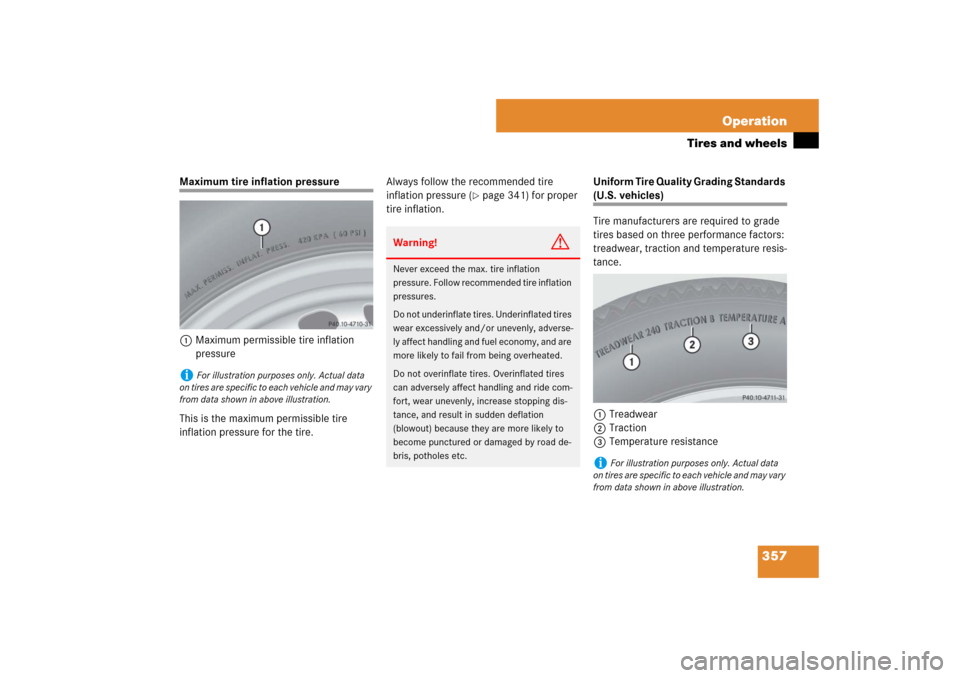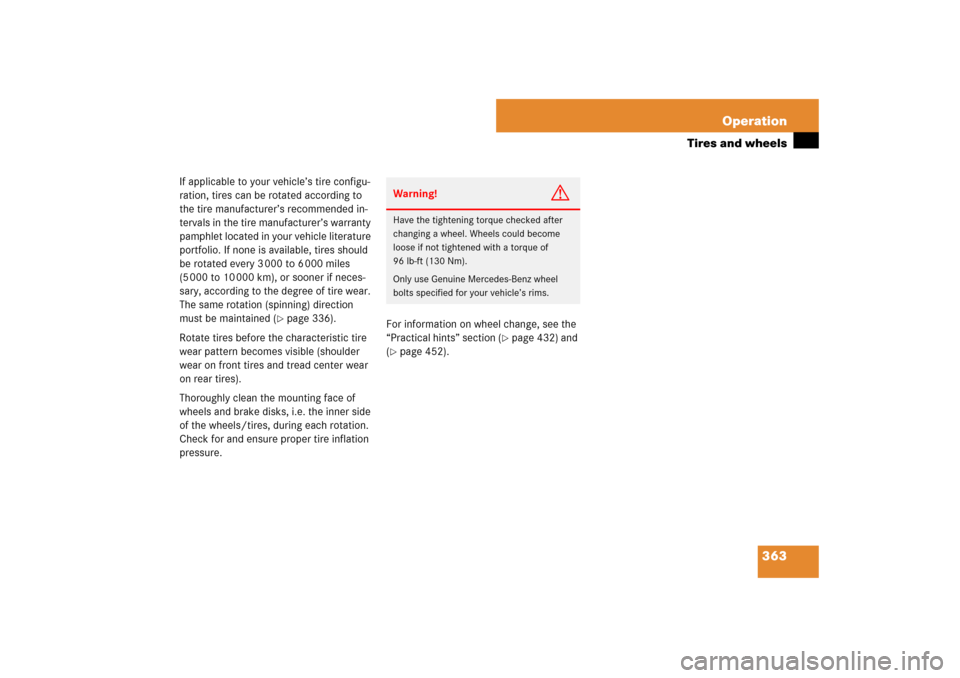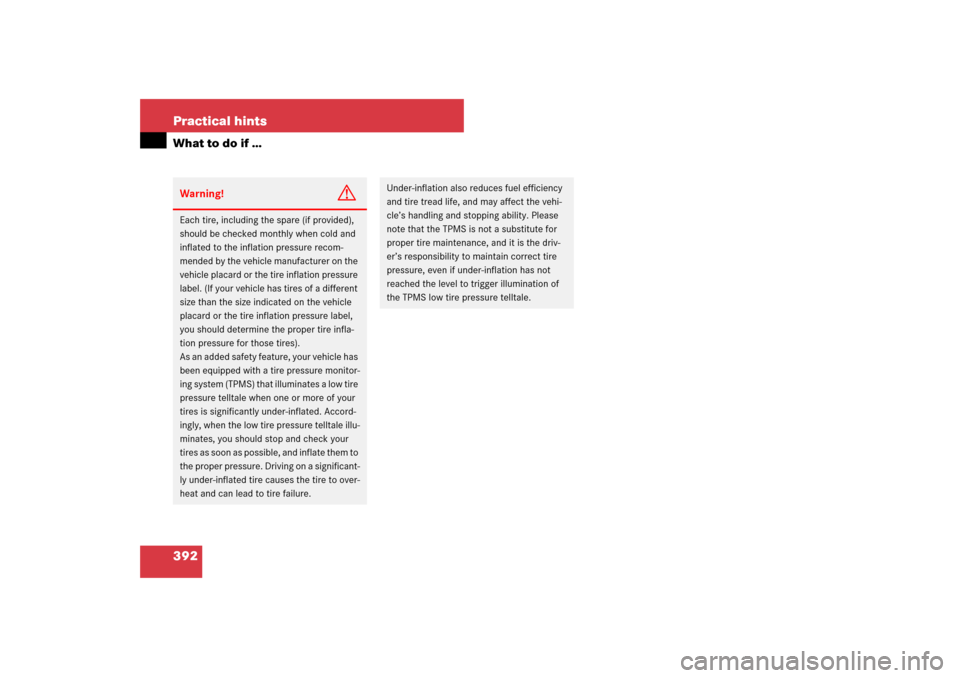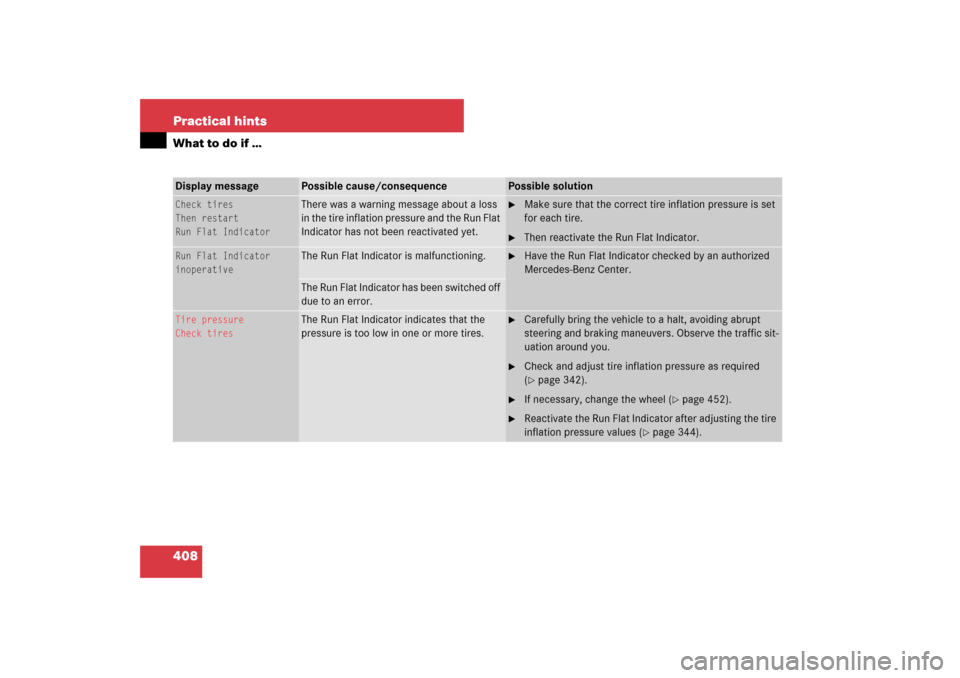Page 351 of 522

350 OperationTires and wheelsTire labeling
Besides tire name (sales designation) and
manufacturer name, a number of markings
can be found on a tire.
Following are some explanations for the
markings on your vehicle’s tires:1Uniform Tire Quality Grading Standards
(
�page 357)
2DOT, Tire Identification Number (TIN)
(�page 355)
3Maximum tire load (
�page 356)
4Maximum tire inflation pressure
(
�page 357)
5Manufacturer
6Tire ply material (
�page 359)
7Tire size designation, load and speed
rating (
�page 350)
8Load identification (
�page 354)
9Tire nameTire size designation, load and speed
rating
1Tire width
2Aspect ratio in %
3Radial tire code
4Rim diameter
5Tire load rating
6Tire speed rating
i
For illustration purposes only. Actual data
on tires are specific to each vehicle and may vary
from data shown in above illustration.
For more information, see “Rims and tires”
(
�page 481).
i
For illustration purposes only. Actual data
on tires are specific to each vehicle and may vary
from data shown in above illustration.
Page 358 of 522

357 Operation
Tires and wheels
Maximum tire inflation pressure
1Maximum permissible tire inflation
pressure
This is the maximum permissible tire
inflation pressure for the tire.Always follow the recommended tire
inflation pressure (
�page 341) for proper
tire inflation. Uniform Tire Quality Grading Standards
(U.S. vehicles)
Tire manufacturers are required to grade
tires based on three performance factors:
treadwear, traction and temperature resis-
tance.
1Treadwear
2Traction
3Temperature resistance
i
For illustration purposes only. Actual data
on tires are specific to each vehicle and may vary
from data shown in above illustration.
Warning!
G
Never exceed the max. tire inflation
pressure. Follow recommended tire inflation
pressures.
Do not underinflate tires. Underinflated tires
wear excessively and/or unevenly, adverse-
ly affect handling and fuel economy, and are
more likely to fail from being overheated.
Do not overinflate tires. Overinflated tires
can adversely affect handling and ride com-
fort, wear unevenly, increase stopping dis-
tance, and result in sudden deflation
(blowout) because they are more likely to
become punctured or damaged by road de-
bris, potholes etc.
i
For illustration purposes only. Actual data
on tires are specific to each vehicle and may vary
from data shown in above illustration.
Page 361 of 522

360 OperationTires and wheelsBar
Another metric unit for air pressure. There
are 14.5038 pounds per square inch (psi)
to 1 bar; there are 100 kilopascals (kPa)
to 1 bar.
Bead
The tire bead contains steel wires wrapped
by steel cords that hold the tire onto the
rim.
Cold tire inflation pressure
Tire inflation pressure when your vehicle
has been sitting for at least 3 hours or driv-
en no more than 1 mile (1.6 km).
Curb weight
The weight of a motor vehicle with stan-
dard equipment including the maximum
capacity of fuel, oil, and coolant, and, if so
equipped, air conditioning and additional
optional equipment, but without passen-
gers and cargo.DOT (D
epartment o
f T
ransportation)
A tire branding symbol which denotes the
tire meets requirements of the
U.S. Department of Transportation.
GAWR (G
ross A
xle W
eight R
ating)
The GAWR is the maximum permissible
axle weight. The gross vehicle weight on
each axle must never exceed the GAWR for
the front and rear axle indicated on the
certification label located on the driver’s
door B-pillar.
GVW (G
ross V
ehicle W
eight)
The GVW comprises the weight of the
vehicle including fuel, tools, spare wheel,
installed accessories, passengers and
cargo and, if applicable, trailer tongue
load. The GVW must never exceed the
GVWR indicated on the certification label
located on the driver’s door B-pillar.GVWR (G
ross V
ehicle W
eight R
ating)
This is the maximum permissible vehicle
weight of the fully loaded vehicle (weight of
the vehicle including all options, passen-
gers, fuel, and cargo and, if applicable,
trailer tongue load). It is indicated on
certification label located on the driver’s
door B-pillar.
Kilopascal (kPa)
The metric unit for air pressure. There are
6.9 kPa to 1 psi; another metric unit for air
pressure is bar. There are 100 kilopascals
(kPa) to 1 bar.
Maximum load rating
The maximum load in kilograms and
pounds that can be carried by the tire.
Maximum loaded vehicle weight
The sum of curb weight, accessory weight,
total load limit, and production options
weight.
Page 362 of 522

361 Operation
Tires and wheels
Maximum tire inflation pressure
This number is the greatest amount of air
pressure that should ever be put in the tire
under normal driving conditions.
Normal occupant weight
The number of occupants the vehicle is
designed to seat, multiplied by
68 kilograms (150 lb).
Occupant distribution
The distribution of occupants in a vehicle
at their designated seating positions.
Production options weight
The combined weight of those installed
regular production options weighing over
5 lb (2.3 kilograms) in excess of those
standard items which they replace, not
previously considered in curb weight or
accessory weight, including heavy duty
brakes, ride levelers, roof rack, heavy duty
battery, and special trim.PSI (P
ounds per s
quare i
nch)
A standard unit of measure for air pressure
-> bar, kilopascal (kPa).
Recommended tire inflation pressure
Recommended tire inflation pressure
listed on Tire and Loading Information
placard located on driver’s door B-pillar for
normal driving conditions. Provides best
handling, tread life and riding comfort.
Rim
A metal support for a tire or a tire and tube
assembly upon which the tire beads are
seated.
Sidewall
The portion of a tire between the tread and
the bead.TIN (T
ire I
dentification N
umber)
Unique identifier which facilitates efforts
by tire manufacturers to notify purchasers
in recall situations or other safety matters
concerning tires and gives purchases the
means to easily identify such tires. The TIN
is comprised of “Manufacturer’s identifica-
tion mark”, “Tire size”, “Tire type code”
and “Date of manufacture”.
Tire load rating
Numerical code associated with the
maximum load a tire can support.
Tire ply composition and material used
This indicates the number of plies or the
number of layers of rubber-coated fabric in
the tire tread and sidewall. Tire manufac-
turers also must indicate the ply materials
in the tire and sidewall, which include
steel, nylon, polyester, and others.
Page 364 of 522

363 Operation
Tires and wheels
If applicable to your vehicle’s tire configu-
ration, tires can be rotated according to
the tire manufacturer’s recommended in-
tervals in the tire manufacturer’s warranty
pamphlet located in your vehicle literature
portfolio. If none is available, tires should
be rotated every 3 000 to 6 000 miles
(5 000 to 10 000 km), or sooner if neces-
sary, according to the degree of tire wear.
The same rotation (spinning) direction
must be maintained (
�page 336).
Rotate tires before the characteristic tire
wear pattern becomes visible (shoulder
wear on front tires and tread center wear
on rear tires).
Thoroughly clean the mounting face of
wheels and brake disks, i.e. the inner side
of the wheels/tires, during each rotation.
Check for and ensure proper tire inflation
pressure.For information on wheel change, see the
“Practical hints” section (
�page 432) and
(
�page 452).Warning!
G
Have the tightening torque checked after
changing a wheel. Wheels could become
loose if not tightened with a torque of
96 lb-ft (130 Nm).
Only use Genuine Mercedes-Benz wheel
bolts specified for your vehicle’s rims.
Page 392 of 522
391 Practical hints
What to do if …
Problem
Possible cause/consequence
Suggested solution
H
Low tire pressure telltale for the
Advanced TPMS* illuminates
continuously.
The Advanced TPMS* detects a loss of
pressure in at least one tire.
�
Carefully bring the vehicle to a halt,
avoiding abrupt steering and braking
maneuvers. Observe the traffic situation
around you.
�
Read and observe messages in the mul-
tifunction display.
If the tire inflation pressure in the respec-
tive tire(s) has (have) been corrected, the
low tire pressure telltale goes out after few
minutes driving.
Page 393 of 522

392 Practical hintsWhat to do if …Warning!
G
Each tire, including the spare (if provided),
should be checked monthly when cold and
inflated to the inflation pressure recom-
mended by the vehicle manufacturer on the
vehicle placard or the tire inflation pressure
label. (If your vehicle has tires of a different
size than the size indicated on the vehicle
placard or the tire inflation pressure label,
you should determine the proper tire infla-
tion pressure for those tires).
As an added safety feature, your vehicle has
been equipped with a tire pressure monitor-
ing system (TPMS) that illuminates a low tire
pressure telltale when one or more of your
tires is significantly under-inflated. Accord-
ingly, when the low tire pressure telltale illu-
minates, you should stop and check your
tires as soon as possible, and inflate them to
the proper pressure. Driving on a significant-
ly under-inflated tire causes the tire to over-
heat and can lead to tire failure.
Under-inflation also reduces fuel efficiency
and tire tread life, and may affect the vehi-
cle’s handling and stopping ability. Please
note that the TPMS is not a substitute for
proper tire maintenance, and it is the driv-
er’s responsibility to maintain correct tire
pressure, even if under-inflation has not
reached the level to trigger illumination of
the TPMS low tire pressure telltale.
Page 409 of 522

408 Practical hintsWhat to do if …Display message
Possible cause/consequence
Possible solution
Check tires
Then restart
Run Flat Indicator
There was a warning message about a loss
in the tire inflation pressure and the Run Flat
Indicator has not been reactivated yet.
�
Make sure that the correct tire inflation pressure is set
for each tire.
�
Then reactivate the Run Flat Indicator.
Run Flat Indicator
inoperative
The Run Flat Indicator is malfunctioning.
�
Have the Run Flat Indicator checked by an authorized
Mercedes-Benz Center.
The Run Flat Indicator has been switched off
due to an error.
Tire pressure
Check tires
The Run Flat Indicator indicates that the
pressure is too low in one or more tires.
�
Carefully bring the vehicle to a halt, avoiding abrupt
steering and braking maneuvers. Observe the traffic sit-
uation around you.
�
Check and adjust tire inflation pressure as required
(�page 342).
�
If necessary, change the wheel (
�page 452).
�
Reactivate the Run Flat Indicator after adjusting the tire
inflation pressure values (
�page 344).